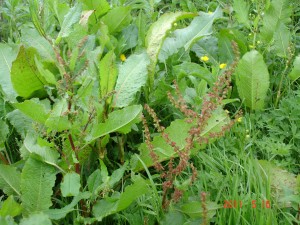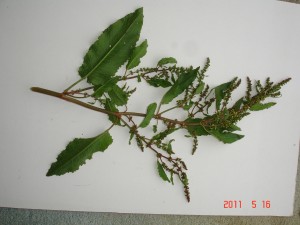Curled Dock
Latin: Rumex crispus
Irish: Copóg chatach
This is a very common native species that grows on roadsides, meadows, arable fields and waste places. In fact, it is so adaptable to different environments that it is said to be one of the five most widely distributed plants in the world.
It is deep-rooted perennial that is extremely difficult to eradicate or control even with modern herbicides. It’s status as an especially difficult weed led to it being categorised as a “Noxious Weed” and landowners allowing it to grow could face prosecution.
It has a more-or-less prostrate growth habit early in the year but as flowering approaches (in June) it tends to grow erect to a height of 1.0m or more. The leaves can be up to 20cm long; 3 to 4 times as long as they are broad and somewhat tapered at both ends. The leaf blades have distinctive wavy or curled edges. The flowers are small but numerous and borne in a dense panicle. They are green initially and turn almost crimson as they mature. It is estimated that a single plant can produce up to 40,000 seeds per year and remain viable in the soil for up to 60 years.
It is probable that the most widely known folk cure in Ireland is the use of dock leaves to alleviate the itching/burning effect cause by stinging nettles.
It can be found at Castlewarden in waste areas (such as the Builder’s Paddock), the motte-and-bailey and along headlands (in the practice area) and in areas where the soil has been disturbed recently.

